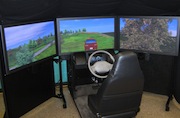
School of Psychology - Georgia Institute of Technology
Overview
The GT Sonification Lab is actively researching driving, and especially in-vehicle activities including infotainment, and developing in-vehicle assistive technologies to help drivers who have perceptual, cognitive, and emotion-related special needs (see the IVAT Project web page).
Much of this research and development leverages a number of driving research capabilities in the Sonification Lab and in the School of Psychology. Here is an overview of our current facilities and capabilities.
GT Simulator Sickness Screening Protocol - GTSSSP
As part of our driving research, the GT Sonification Lab has developed a predictive simulator sicknessis screening protocol. It involves a baseline survey, a short drive in the simulator, and a post-drive survey. Scoring the post-drive survey allows researchers to predict whether a participant is likely to experience the discomfort associated with simulator sickness. Those participants can be excused from the study before symptoms become uncomfortable.
The entire protocol, including a Tech Report [GTSSSP--GT-PSYC-TechReport-2013-01.pdf] in PDF format that describes the procedure, the surveys, electronic survey delivery application (Java), and NADS MiniSim driving scenario, are available for download and use on our GT Simulator Sickness Screening Protocol page. We ask only that you cite our Tech Report and subsequent research papers, and let us know of any problems with, or enhancements to the protocol.
NADS MiniSim Driving Simulator
 The GT School of Psychology runs a National Advanced Driving Simulators (NADS) MiniSim. This is a very popular, powerful, flexible, but also affordable mid-fidelity simulation platform, with academic, corporate, and clinical users all over North America. Ours is a 3 channel, quarter-cab model (this includes a real car seat, steering wheel, pedals, and dashboard), in a dedicated research and testing suite.
The GT School of Psychology runs a National Advanced Driving Simulators (NADS) MiniSim. This is a very popular, powerful, flexible, but also affordable mid-fidelity simulation platform, with academic, corporate, and clinical users all over North America. Ours is a 3 channel, quarter-cab model (this includes a real car seat, steering wheel, pedals, and dashboard), in a dedicated research and testing suite.
More details: The simulation software runs on a single computer, running Microsoft Windows 7 Pro on an Intel Core i7 processor, 3.07 GHz and 12 GB of RAM, and relays sound through a 2.1 audio system. Three Panasonic TH-42PH2014 42" plasma displays, each with a 1280x800 pixel resolution, allow for a cumulative 130 degree field of view in front of the seated participant. The center monitor is 28 inches from the center of the steering wheel and the left and right monitors are 37 inches from the center of the steering wheel. The MiniSim also includes a real steering wheel with on-column gear shift, adjustable car seat, real gas and brake pedals, as well as a Toshiba Ltd. WXGA TFT LCD monitor with a 1280x800 resolution to display the speedometer, etc. Environmental sound effects are played through two embedded speakers. These sounds include engine noise, brake screech, turn indicators, collisions, etc.
Enhancements: We have enhanced our simulator
 with additional computers that drive in-vehicle/infotainment displays, and we can collect data from the simulator (using our own custom-developed software to interface with the MiniSIM data in real time from another computer) or from participants directly.
with additional computers that drive in-vehicle/infotainment displays, and we can collect data from the simulator (using our own custom-developed software to interface with the MiniSIM data in real time from another computer) or from participants directly.
The facility includes driver-facing and front-facing cameras, microphones, touch screens, and multichannel surround sound audio. There are a variety input devices available, such as touch pads, Kinect sensors, and LEAP Motion hand trackers. We have Tobii eye tracking glasses (including custom-built pupilometry software)
Psychology Driving Research
Driving in a simulator can be an effective research environment; for many research and development projects, it is very important that the simulated driving environment be a match to a specific location. For example, in some cases a person's familiarity with the streets and buildings of their own city affects their driving behavior (or, say, their use of an in-vehicle GPS system), so it is crucial to be able to provide a research environment that models the real world driving situation. And, further, in some projects, driving in the simulator can serve as training or practice for driving a real car, later on. As an example, our ongoing work with Shepherd Center will develop in-vehicle technologies to help people with traumatic brain injuries (TBI) as they return to driving. Our driving simulator (with Atlanta roads) allows a driver to learn to utilize the technologies, while practicing driving in their own neighborhoods. This can also allow the rehab specialists to clearly and accurately assess the readiness of drivers to step out of the simulator, and get behind the wheel of a real car, on the real streets.
Atlanta Simulation Development and Architecture Research
 In order to develop a simulation of the Georgia Tech campus, the surrounding roads of
Midtown Atlanta, and the area around Shepherd Center, the GT School of Architecture is developing a 3D virtual model of Georgia Tech, Midtown, and 26 miles of Peachtree Street (the Peachtree Corridor), but in its current format it is not readily usable in the driving simulator that utilizes NADS-unique file/data formats and structures. We have developed a pipeline and process to take the 3D geometry and textures developed by the School of Architecture, in industry-standard CAD and 3D visualization packages (e.g., AutoCAD and 3D Studio Max), and automatically (or semi-automatically) convert and parse them in order to generate a custom virtual environment database for the NADS MiniSim driving simulator.
In order to develop a simulation of the Georgia Tech campus, the surrounding roads of
Midtown Atlanta, and the area around Shepherd Center, the GT School of Architecture is developing a 3D virtual model of Georgia Tech, Midtown, and 26 miles of Peachtree Street (the Peachtree Corridor), but in its current format it is not readily usable in the driving simulator that utilizes NADS-unique file/data formats and structures. We have developed a pipeline and process to take the 3D geometry and textures developed by the School of Architecture, in industry-standard CAD and 3D visualization packages (e.g., AutoCAD and 3D Studio Max), and automatically (or semi-automatically) convert and parse them in order to generate a custom virtual environment database for the NADS MiniSim driving simulator.
Just as importantly, we have developed methods to take any 3D shell/surface-polygonal model (presumably of any city, or even of the surface of the moon), and pipeline it into the NADS MiniSim driving simulator. Of course, eventually we plan to be able to push any section of, say, Google or Apple 3D Maps into the miniSim platform!
Here are some images of the GT campus being imported into the MiniSim, and some videos of initial drivable models (low resolution, which is being upped to medium-poly resolution).
Additional Simulators
The Sonification Lab also runs additional desktop driving simulators, which are used to collect data directly, and in some cases used to pilot studies that will then be transitioned to the NADS MiniSim. We run a variety of software, including the Daimler Lane Change Task, among others. We have Tobii eye tracking and multichannel audio integrated, as well as supporting Kinect, LEAP, trackpads, and other devices.
People
Thom Gable
Myounghoon "Philart" Jeon
Julia Olsheski (née DeBlasio)
Publications Relating to the Research
(See the Publications page for all Sonification Lab publications.)
in press
(Note: Please do not quote or cite preprints without permission.)
2009
Acknowledgments
This research has been supported, in part, by grants from the National Science Foundation (NSF), Centrafuse, Panasonic Automotive Systems of America, and Toyota Research. Any opinions, findings, and conclusions or recommendations expressed in this material are those of the author(s) and do not necessarily reflect the views of the funding agencies or sponsors.

Contact Us:
Georgia Tech Sonification Lab
Bruce Walker